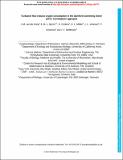Files in this item
Turbulent flow reduces oxygen consumption in the labriform swimming shiner perch, Cymatogaster aggregata
Item metadata
| dc.contributor.author | van der Hoop, Julie M. | |
| dc.contributor.author | Byron, Margaret L. | |
| dc.contributor.author | Ozolina, Karlina | |
| dc.contributor.author | Miller, David L. | |
| dc.contributor.author | Johansen, Jacob L. | |
| dc.contributor.author | Domenici, Paolo | |
| dc.contributor.author | Steffensen, John F. | |
| dc.date.accessioned | 2019-04-02T23:37:59Z | |
| dc.date.available | 2019-04-02T23:37:59Z | |
| dc.date.issued | 2018-06-12 | |
| dc.identifier | 253147472 | |
| dc.identifier | 8c09da47-321b-48d3-88bd-afbfc96ea43c | |
| dc.identifier | 000438916100004 | |
| dc.identifier | 85072390254 | |
| dc.identifier.citation | van der Hoop , J M , Byron , M L , Ozolina , K , Miller , D L , Johansen , J L , Domenici , P & Steffensen , J F 2018 , ' Turbulent flow reduces oxygen consumption in the labriform swimming shiner perch, Cymatogaster aggregata ' , Journal of Experimental Biology , vol. 221 , no. 11 , 168773 . https://doi.org/10.1242/jeb.168773 | en |
| dc.identifier.issn | 0022-0949 | |
| dc.identifier.other | Bibtex: urn:0f7fd0f1e7b3620e50d187ae4b2360ac | |
| dc.identifier.uri | https://hdl.handle.net/10023/17424 | |
| dc.description.abstract | Fish swimming energetics are often measured in laboratory environments which attempt to minimize turbulence, though turbulent flows are common in the natural environment. To test whether the swimming energetics and kinematics of shiner perch Cymatogaster aggregata (a labriform swimmer) were affected by turbulence, two flow conditions were constructed in a swim-tunnel respirometer. A low-turbulence flow was created using a common swim-tunnel respirometry setup with a flow straightener and fine-mesh grid to minimize velocity fluctuations. A high-turbulence flow condition was created by allowing large velocity fluctuations to persist without a flow straightener or fine grid. The two conditions were tested with Particle Image Velocimetry to confirm significantly different turbulence properties throughout a range of mean flow speeds. Oxygen consumption rates of the swimming fish increased with swimming speeds and pectoral fin beat frequencies in both flow conditions. Higher turbulence also caused a greater positional variability in swimming individuals (vs. low-turbulence flow) at medium and high speeds. Surprisingly, fish used less oxygen in high turbulence compared to low-turbulence flow at medium and high swimming speeds. Simultaneous measurements of swimming kinematics indicated that these reductions in oxygen consumption could not be explained by specific known flow-adaptive behaviours such as Kármán-gaiting or entraining. Therefore, fish in high-turbulence flow may take advantage of the high variability in turbulent energy through time. These results suggest that swimming behavior and energetics measured in the lab in straightened flow, typical of standard swimming respirometers, might differ from that of more turbulent, semi-natural flow conditions. | |
| dc.format.extent | 11 | |
| dc.format.extent | 2356146 | |
| dc.language.iso | eng | |
| dc.relation.ispartof | Journal of Experimental Biology | en |
| dc.subject | Vortex | en |
| dc.subject | Eddy | en |
| dc.subject | Gait | en |
| dc.subject | Swimming kinematics | en |
| dc.subject | Metabolism | en |
| dc.subject | Space use | en |
| dc.subject | QA Mathematics | en |
| dc.subject | QH301 Biology | en |
| dc.subject | SH Aquaculture. Fisheries. Angling | en |
| dc.subject | NDAS | en |
| dc.subject.lcc | QA | en |
| dc.subject.lcc | QH301 | en |
| dc.subject.lcc | SH | en |
| dc.title | Turbulent flow reduces oxygen consumption in the labriform swimming shiner perch, Cymatogaster aggregata | en |
| dc.type | Journal article | en |
| dc.contributor.institution | University of St Andrews. School of Mathematics and Statistics | en |
| dc.contributor.institution | University of St Andrews. Applied Mathematics | en |
| dc.contributor.institution | University of St Andrews. Centre for Research into Ecological & Environmental Modelling | en |
| dc.identifier.doi | https://doi.org/10.1242/jeb.168773 | |
| dc.description.status | Peer reviewed | en |
| dc.date.embargoedUntil | 2019-04-03 |
This item appears in the following Collection(s)
Items in the St Andrews Research Repository are protected by copyright, with all rights reserved, unless otherwise indicated.

